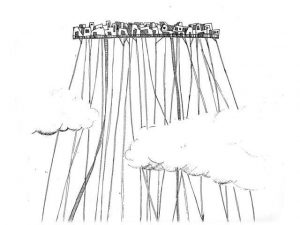
In the piece ‘Migratory Cities’ by Carl Abbott, the author proposes the questions “what if a city could move?” and “what is gained and what is lost when a city pulls up stakes?” This raises the issue of what purpose a city has, which led me to think about what defines a city: is it the land it lies on? Or is it the inhabitants that make the state? I think that though we can distinguish cities from others by determining the piece of land it has, a city is defined through its people and their ways of living. It is built on a community: without citizens to call a place ‘home’, the city is simply a piece of land, belonging to nothing and no one. Through this line of reasoning, a city can be found anywhere, as long as there is an existing community that belongs to it.
The reading also expanded on the political implications of a city physically moving: a city that is eternally in motion can be granted political freedom. It is no longer chained or limited to any absolute laws tied to a land and, by fleeing, it has essentially escaped whatever it deems undesirable or unfit for the state. I find this idea very interesting as it suggests that a city in eternal motion is free and independent, characteristics that would usually be assigned to people rather than cities. I think this further supports the claim that cities are defined and driven through its inhabitants.
Whilst reading this and considering the implications a ‘moving city’ would raise, I was also reminded of a passage in Italo Calvino’s ‘Invisible Cities’, a meditating read with rich descriptions of about 50 cities. In this novel, the city Baucis is described as having “slender stilts that rise from the ground at a great distance from one another and are lost above the clouds” that support the city. “You climb them with ladders… Nothing of the city touches the earth except those long flamingo legs on which it rests and, when the days are sunny, a pierced, angular shadow that falls on the foliage.” (Though this particular city is not one that moves, my mind still drifted to it due to the physical appearance it is described as having; the idea of a city having ‘legs’ leaves an impression of motion or of change.) Overall, the pure visuals that arise from this neo-futuristic concept is definitely something I would enjoy seeing appear more in media.
By: Saima Abidi (UID: 3035552856)